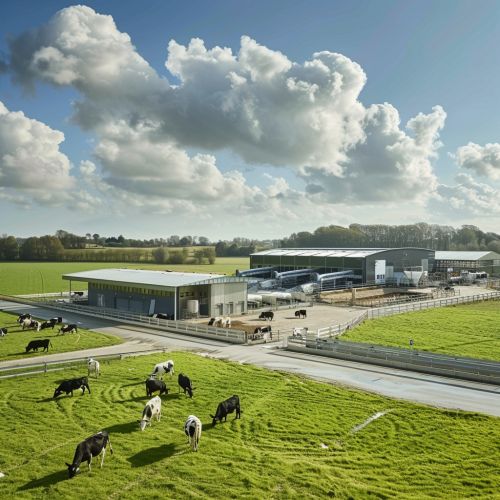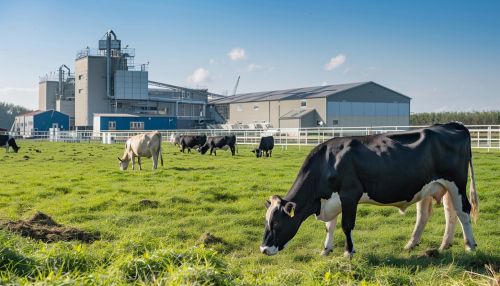Dairy industry
Overview
The Dairy industry is a sector of the agriculture industry that deals with the production, processing, and distribution of milk and milk products. This industry plays a crucial role in the global food system and contributes significantly to the economy of many countries. The dairy industry is multifaceted, encompassing a wide range of activities from the care and feeding of dairy animals, primarily cows, to the processing of raw milk into a variety of dairy products, and the marketing and distribution of these products to consumers.


History
The history of the dairy industry dates back to the domestication of animals, when humans first began to raise animals for milk production. The first dairy animals were likely sheep and goats, which were domesticated in the Middle East around 8000 BC. The domestication of cattle, which are now the primary dairy animal, occurred a few thousand years later. The development of the dairy industry has been influenced by a variety of factors, including technological advancements, changes in consumer demand, and shifts in agricultural policy.
Dairy Production
Dairy production involves the rearing of dairy animals, primarily cows, for the purpose of milk production. This process includes a variety of activities, such as feeding, breeding, and health management. The productivity of dairy animals is influenced by a variety of factors, including genetics, nutrition, and management practices. The goal of dairy production is to produce high-quality milk in a sustainable and efficient manner.
Milk Processing
Once milk has been collected from dairy animals, it undergoes a series of processing steps to ensure its safety and quality. This process, known as milk processing, involves several stages, including pasteurization, homogenization, and packaging. Pasteurization is a heat treatment process that kills harmful bacteria in the milk, while homogenization breaks down the fat globules in the milk to prevent them from separating. The processed milk is then packaged and prepared for distribution.
Dairy Products
The dairy industry produces a wide range of products, including liquid milk, cheese, yogurt, butter, and ice cream. These products are made through various processes that alter the physical and chemical properties of the milk. For example, cheese is made by adding bacteria to the milk to ferment the lactose, which produces lactic acid and causes the milk to curdle. The curdled milk is then cut, heated, and pressed to form cheese.
Marketing and Distribution
The marketing and distribution of dairy products is a crucial aspect of the dairy industry. This involves promoting the products to consumers, transporting the products to retail outlets, and ensuring that the products are available for purchase. The marketing and distribution of dairy products is influenced by a variety of factors, including consumer preferences, market trends, and regulatory requirements.
Economic Impact
The dairy industry has a significant economic impact, contributing to the income of farmers, processors, and retailers, and providing employment opportunities in rural areas. The industry also contributes to the economies of countries through exports of dairy products. However, the economic viability of the dairy industry is influenced by a variety of factors, including the cost of production, the price of milk and dairy products, and the policies and regulations affecting the industry.
Environmental Impact
The dairy industry also has an environmental impact, primarily through the production of greenhouse gases, the use of water and land resources, and the generation of waste. The industry is taking steps to reduce its environmental impact through the adoption of sustainable practices, such as improved manure management, efficient use of water and energy, and the reduction of greenhouse gas emissions.
Challenges and Future Trends
The dairy industry faces a number of challenges, including fluctuating milk prices, increasing production costs, changing consumer preferences, and concerns about animal welfare and environmental sustainability. However, the industry is also experiencing new trends and opportunities, such as the growth of the organic dairy sector, the development of innovative dairy products, and the increasing demand for dairy products in emerging markets.
